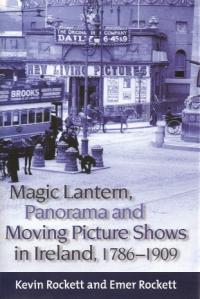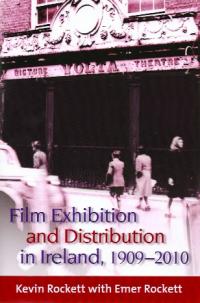Magic lantern, panorama and moving picture shows in Ireland, 1786–1909 Film exhibition and distribution in Ireland, 1909–2010 Kevin and Emer Rockett (Four Courts Press, €45 and €55) ISBN 9781846823152, 9781846823169
Published in 18th–19th - Century History, 20th-century / Contemporary History, Book Reviews, Issue 3 (May/June 2012), Reviews, Volume 20
Magic lantern, panorama and moving picture shows in Ireland, 1786–1909
Kevin and Emer Rockett
(Four Courts Press, €45
ISBN 9781846823152
Over the course of the eighteenth century there was an increasing focus on spectacular forms of entertainment, ranging from peep-shows and waxworks to magic lantern shows and theatrical effects, which prefigure the idea of ‘going to the pictures’. While many of these entertainment techniques remained experimental or confined to the élite, once the Irish-born Robert Barker (1729–1806) began creating full 360-degree images of Edinburgh and London in 1786 these prehistoric forms of cinema were to become hugely popular, especially among working-class audiences.
Kevin and Emer Rockett’s Magic lantern, panorama and moving picture shows in Ireland, 1786–1909 seeks to develop this prehistory, looking at the explorations of moving images which took place in Ireland. It is presented as a companion volume to Film exhibition and distribution in Ireland, 1909–2010, and together they give a comprehensive account of ‘going to the pictures’ in Ireland. The first book begins with the magic lantern and, among other things, explores the possibility that the 1879 apparition at Knock may have been produced by a magic lantern, possibly by Archdeacon Bartholomew Cavanagh showing slides of the new statues ordered for the church on the gable wall. The second chapter explores the panorama and other pre-cinema moving images, including the work of Philippe de Loutherberg (1740–1812), equally prominent as a set designer, painter and illustrator. De Loutherberg’s ‘eidophusikon’ created a sensation in Dublin in the early 1790s. This included a view of ‘Miltonic hell’ in which Beelzebub and Moloch arose from a lake of fire, striking terror into the audience.

Film exhibition and distribution in Ireland, 1909–2010
Kevin and Emer Rockett
(Four Courts Press €55)
ISBN 9781846823169
The importance of the panorama in Dublin’s cultural life throughout the nineteenth century is also detailed, including a famous confrontation between ‘high art’ and the moving panorama in Dublin in 1821. Théodore Géricault’s painting Raft of the Medusa (1819), shown at the Rotunda, failed to compete with Marshall’s ‘peristrephic’ panorama on the same theme. The panorama’s cheap seats were half the price of going to see Géricault’s painting, and the show featured 10,000 square feet of moving paintings, a band and narrator, shown in a purpose-built panorama pavilion on Lower Abbey Street.
The next chapter feels like something of a digression, as, with the exception of a discussion of the popularity of tableaux vivantes, there is little here that relates to the moving image. The tableaux vivantes were able to exploit the conventional acceptance of nudity in ‘art’ in order to provide audiences with a display of bare flesh, although puritanical pressures led to their decline by the mid-century. The final section of the book looks at the arrival of photographic moving pictures in various guises such as the mutoscope and the kinetoscope, transitional forms between peep-shows and the cinema proper. Apart from the content of these early films, the focus is primarily on the development of a network of exhibition venues in Dublin, and a route for travelling exhibitors around the country.
While it contains much fascinating material, the book is quite a struggle to read, as the writing is very ponderous right from the opening sentence:
‘Even when viewing an image from the same physical location, people necessarily see (and interpret) it differently; however since the nineteenth century and the increasing generalized use of spectacles (first developed in Italy towards the end of the thirteenth century as a means of equalizing physical views of the world), this owes less to biology and the “natural” physiology of the eye and more to cultural and social influences.’
More seriously, the book’s focus is almost entirely restricted to Dublin, and as a result ignores several important aspects of popular visual culture of the nineteenth century, such as the role of tableaux in the Repeal movement. Belfast in particular is virtually ignored, thus missing the opportunity to explore the links between sign-writing, banner-making and the panorama from the 1840s on, as well as the impact of the magic lantern on loyalist mural painting. This may be partly due to the book’s avowedly ‘post-colonialist’ position, which renders it hostile to anything smacking of supposedly metropolitan imperialism, while disregarding cultural differences within Ireland as a whole.
Film exhibition and distribution in Ireland, 1909–2010 is more narrowly focused and the authors seem to be on much more comfortable ground here. The first part of the book looks at the development of the commercial cinema in Ireland, especially the siting of the cinemas themselves and the cultural issues involved, and gives a detailed account of the personalities engaged in the business. This is followed by a fascinating account of the struggle between the ‘cultural cinema’ movement and the agenda of the Irish Catholic church. Of particular interest is Fr Devane’s promotion in 1935 of an Irish film institute to develop cinema on ‘thoroughly organized’ lines—such as was being done in Spain, Germany, Italy and the USSR. The third section gives what is described as ‘the first attempt’ at a comprehensive list of cinemas and public screening venues in Ireland, including details of ownership and the size of the screen, where available, which will be a treasure trove for students. HI
John Mulloy lectures in art history and critical theory at the Galway–Mayo Institute of Technology, Castlebar.
















